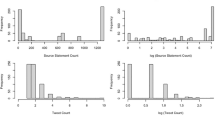Abstract
We apply the reduced Google matrix method to analyze interactions between 95 terrorist groups and determine their relationships and influence on 64 world countries. This is done on the basis of the Google matrix of the English Wikipedia (2017) composed of 5 416 537 articles which accumulate a great part of global human knowledge. The reduced Google matrix takes into account the direct and hidden links between a selection of 159 nodes (articles) appearing due to all paths of a random surfer moving over the whole network. As a result we obtain the network structure of terrorist groups and their relations with selected countries including hidden indirect links. Using the sensitivity of PageRank to a weight variation of specific links we determine the geopolitical sensitivity and influence of specific terrorist groups on world countries. The world maps of the sensitivity of various countries to influence of specific terrorist groups are obtained. We argue that this approach can find useful application for more extensive and detailed data bases analysis.
Similar content being viewed by others
References
M. Sageman, Understanding terror networks (University of Pennsylvania Press, Philadelphia, 2004)
G. Kepel, Jihad: the trail of political Islam (I.B. Tauris & Co Ltd, New York, 2006)
G. Kepel, A. Jardin, Terreur dans l’Hexagone. Genèse du djihad francais (Gallimard, Paris, 2015)
M. Sageman, Turning to political violence: the emergence of terrorism (University of Pennsylvania Press, Philadelphia, 2017)
Standford University Project, Mapping militant organizations, http://web.stanford.edu/group/mappingmilitants/cgi-bin/ (accessed 2017/23/08)
Wikipedia contributors, List of designated terrorist groups, Wikipedia, the free Encyclopedia (2017), https://en.wikipedia.org/wiki/List_of_designated_terrorist_groups (accessed 2017/23/08)
S. El Zant, K.M. Frahm, K Jaffrès-Runser, D.L. Shepelyansky, http://www.quantware.ups-tlse.fr/QWLIB/wikiterrornetworks/ (accessed 2017/10/10)
D.L. Hicks, N. Memon, J.D. Farley, T. Rosenorn, in Mathematical methods in counterterrorism: tools and techniques for a new challenge, edited by D.L. Hicks, N. Memon, J.D. Farley, T. Rosenorn (Springer-Verlag, Wien, 2009)
V. Latora, M. Marchiori, Chaos Solitons Fractals 20, 69 (2004)
S. Dorogovtsev, Lectures on complex networks (Oxford University Press, Oxford, 2010)
S. Brin, L. Page, Comput. Netw. ISDN Syst. 30, 107 (1998)
L. Ermann, K.M. Frahm, D.L. Shepelyansky, Rev. Mod. Phys. 87, 1261 (2015)
A.M. Langville, C.D. Meyer, Google’s PageRank and beyond: the science of search engine rankings (Princeton University Press, Princeton, 2006)
Y.-H. Eom, P. Aragon, D. Laniado, A. Kaltenbrunner, S. Vigna, D.L. Shepelyansky, PLoS One 10, e0114825 (2015)
L. Ermann, D.L. Shepelyansky, Eur. Phys. J. B 88, 84 (2015)
J. Lages, A. Patt, D.L. Shepelyansky, Eur. Phys. J. B 89, 69 (2016)
K.M. Frahm, D.L. Shepelyansky, arXiv:1602.02394 [physics.soc] (2016)
K.M. Frahm, K. Jaffrès-Runser, D.L. Shepelyansky, Eur. Phys. J. B 89, 269 (2016)
K.M. Frahm, S. El Zant, K. Jaffrès-Runser, D.L. Shepelyansky, Phys. Lett. A 381, 2677 (2017)
K.M. Frahm, D.L. Shepelyansky, Wikipedia networks of 24 editions of 2017, http://www.quantware.ups-tlse.fr/QWLIB/24wiki2017 (accessed 2017/09/10)
M. Gabella, arXiv:1708.05368 [physics.soc-ph] (2017)
M. Tsvetkova, R. Garcia-Gavilanes, L. Floridi, T. Yasseri, PLoS ONE 12, e0171774 (2017)
A. Thalhammer, A. Rettinger, Lect. Notes Comput. Sci. 9989, 227 (2016)
T. Guhr, A. Nueller-Groeling, H.A. Weidenmueller, Phys. Rep. 299, 189 (1998)
K. Ban, M. Perc, Z. Levnajic, R. Soc. Open Sci. 4, 171217 (2017)
L.T.C. Geoffrey Kambere, UPDF, Financing Al Shahabaab: the vital port of Kismayo, https://globalecco.org/financing-al-shabaab-the-vital-port-of-kismayo (accessed 2017/23/08)
M. Mcnamara, The Taliban in Afghanistan (CBS News, 2006), https://www.cbsnews.com/news/the-taliban-in-afghanistan/ (accessed 2017/23/08)
S.N. Ogata, The turbulent decade: confronting the refugee crises of the 1990s (W. W. Norton and Company, New York, 2005)
Yemen crisis: who is fighting whom? (BBC News, 2017), http://www.bbc.com/news/world-middle-east-29319423 (accessed 2017/23/08)
T. O’Connor, Middle East Conflict: Why is Saudi Arabia Attacking Yemen? Important Questions Surround Houthis and Civil War in Sana’a (IBT Times, 2016), http://www.ibtimes.com/middle-east-conflict-why-saudi-arabia-attacking-yemen-important-questions-surround-2447121 (accessed 2017/23/08)
D. Walsh, WikiLeaks cables portray Saudi Arabia as a cash machine for terrorists (The Guardian, 2010), https://www.theguardian.com/world/2010/dec/05/wikileaks-cables-saudi-terrorist-funding (accessed 2017/23/08)
Who are Somalia’s al-Shabab? (BBC News, 2016), http://www.bbc.com/news/world-africa-15336689 (accessed 2017/23/08)
E.M. Saltman, C. Winter, Islamic state: the changing face of modern Jihadism (Quillam, 2014)
D. Helbing, D. Brockmann, T. Chadefaux, K. Donnay, U. Blanke, O. Woolley-Meza, M. Moussaid, A. Johansson, J. Krause, S. Schutte, M. Penc, J. Stat. Phys. 158, 735 (2015)
M.R. D’Orsogna, M. Perc, Phys. Life Rev. 12, 1 (2015)
S. Vigna, Personal web page, http://vigna.di.unimi.it/ (accessed 2017/23/08)
NADINE EC FET Open project web page, http://www.quantware.ups-tlse.fr/FETNADINE/ (accessed 2017/23/08)
M. Bastian, S. Heymann, M. Jacomy Gephi, An open source software for exploring and manipulating networks, in Proceedings of International AAAI Conference on Weblogs and Social Media (2009)
Y. Hu, Math. J. 10, 1 (2006)
Author information
Authors and Affiliations
Corresponding author
Rights and permissions
About this article
Cite this article
El Zant, S., Frahm, K.M., Jaffrès-Runser, K. et al. Analysis of world terror networks from the reduced Google matrix of Wikipedia. Eur. Phys. J. B 91, 7 (2018). https://doi.org/10.1140/epjb/e2017-80570-0
Received:
Revised:
Published:
DOI: https://doi.org/10.1140/epjb/e2017-80570-0




